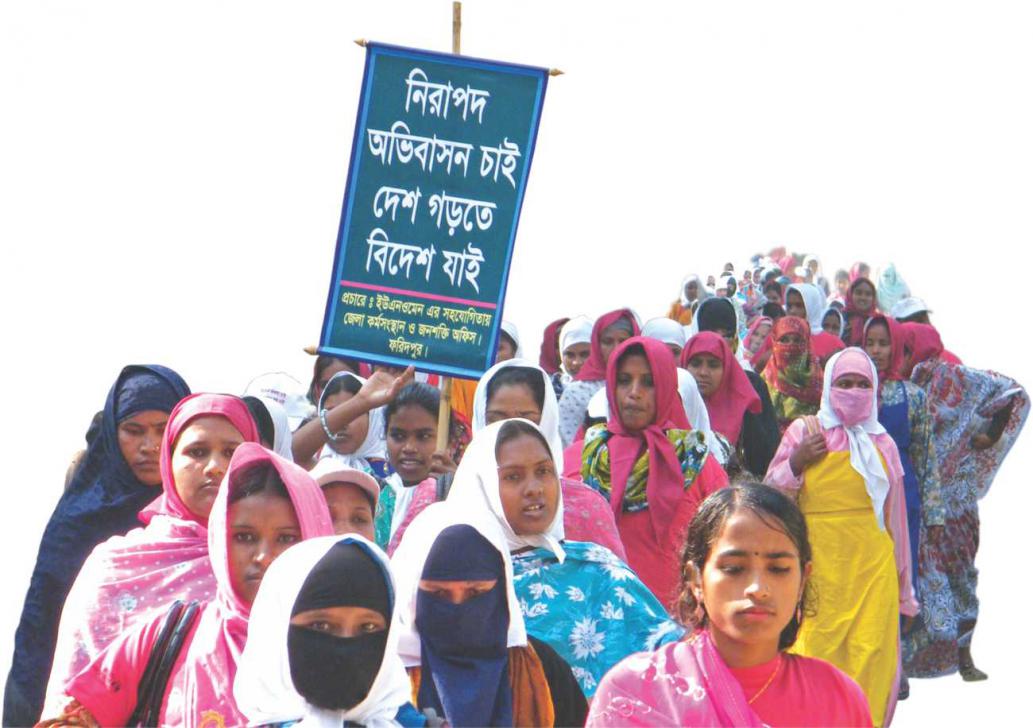
In 1970, scholars Marvin and Berry lamented the lack of empirical literature linking migrant labour to economic development ignoring primarily the experiences of developing countries. They coined the phrase “the movement of economically productive individuals” as a way of making this important link where they “define as mobile and economically productive all individuals who move from their home area and while away from it receive income as a result of their activity or wealth” (Marvin,P. & Berry,S., 1970, p. 87). The literature on the role of migrant labouras an important pillar of social and economic development and maldevelopment has grown exponentially since then. The literature has focused primarily on the abuses experienced by migrant workers under various sovereign governments and host employers; something Bangladeshis are only too aware of. For the host countries this flow of labour provides low cost surplus workers to many export driven and domestic economies, including countries like Canada, the United States, western European counties, the Middle Eastern Gulf States, Japan and the Asian Tigers and Cub States like South Korea, Singapore, Malaysia and Thailand. The development impact of remittances by migrant workers to their families back home is seen as one of the most important economic pillars in low and middle income countries such as India, Nepal, Bangladesh, the Philippines, Myanmar, Mexico, Jamaica, Ethiopia, Cameroun and such remote, faraway places like Kiribati in the South Pacific.
High income countries (HICs) have significant labour market needs to support their export and domestic economies, linked to a demographic time bomb of low birth rates and an aging population. This is coupled with a very high education level among those joining the workforce,young people who are looking at career options in higher waged, professional sectors.In some countries, especially in oil rich Gulf States, this is further complicated by the fact that women are not able to participate in certain sectors of the economy. A labour market gap therefore exists in many sectors, most notably in agriculture, fisheries, textiles, construction, domestic, health and home care. Much of the literature refers to these skill sets as low and semi-skilled. I would argue that this is erroneous and reflects our own set of values as to what is considered meaningful and important work. While many of these sectors can be deemed dirty, dangerous and difficult, the 3D work spaces as defined in the literature, they are not unimportant, unskilled work spaces. The Ikiribati man who has worked on German container ships for 10 years is not unskilled, nor is a Philipino nurse/care giver in Canada after 25 years of service or a domestic worker in Lebanon who is about to start her third, 3-year contract.
The levels of abuse reported by migrant workers in various work spaces and countries are too numerous to list. Some, however, are consistent such as employers confiscating passports to control mobility (part of the Kafala system well known to Bangladeshis working in the Gulf States), withholding wages and benefits, physical and mental mistreatment and sexual abuse. Extreme cases involve tricking women with false promises leading many into forced sex work. Some cases have resulted in the death of migrant workers. This has been documented by human rights groups in Israel, for example, where Thai agricultural migrant workers have died from over work under extreme heat. Between 2008 and 2013, 122 Thai workers died in Israel. There are 25,000 Thai agricultural workers in Israel’s highly development agricultural sector (The Bangkok Post, 2015).

Some sending country governments are also looking into abuses of their citizens in foreign countries. The Thai government is investigating the abuse and deaths of Thai agricultural migrant workers in Israel. Various African and Asian countries (Sri Lanka, Philippines, Indonesia, Ethiopia, Malawi to name a few) have stopped the flow of women migrant workers to various Gulf States after receiving stories of extreme physical and sexual abuse (Middle East Voices, 2014). Bangladesh has gone further by not allowing women under the age of 35 to migrate to other countries. This does not apply to professional
categories (Siddiqui, T., 2005, p. 8).
The GWP in Canada has increased significantly over the past 10 years. However, compared to other high income countries, the number is quite small but it is growing. The Canadian government manages temporary labour migration programmes such as the Temporary Foreign Worker Programme (TFWP), Caregiver Programme (CP), and Seasonal Agricultural Worker Programme (SAWP). In 2015, the total number of people under this legal temporary status was 73,222 with the top three countries being Mexico (22,983), Philippines (11,758) and Jamaica (8,567) (The Canadian Magazine on Immigration, 2015). There have been critiques of the programme coming from both the left and the right in Canada. Migrant and refugee advocacy groups have lobbied for the Canadian government to ensure maximum worker safety and fair wage rights as well as a pathway to full citizenship. Groups such as the Canadian Council on Refugees are advocating for Canada to continue managing the various migration schemes that will ensure the protection of workers’rights. The CCR is advocating for Canada to pursue an immigration policy that provides temporary migrant workers with apathway to Canadian citizenship (Canadian Council for Refugees, 2016, p. 7). The new Liberal government seems to have listened as new policies are being put in place to provide more rights and privileges to temporary migrant workers. The battle is not entirely won and advocacy groups across the country continue to monitor the situation in various sectors but its’ a good beginning.
There have been abuses to the programme by companies such as Canadian Tires, Tim Horton’s and even the Royal Bank of Canada, hiring migrant workers where Canadians could have assumed these jobs. Many larger companies will try to recruit people at entry level salaries often not acceptable to Canadians.
This is all linked to the need for Canada to increase its minimum wage requirements across the country to ensure that a living wage is guaranteed. This could go a long way in curbing this corporate abuse. In many small, rural communities in Canada, however, GWPs have been very beneficial to local employers and the wider community. As an example, small fishing communities across Atlantic Canada have benefitted from the temporary GWPs.
In my native province of Nova Scotia on the east coast of Canada,the fishing industry is the backbone of the community. Growing up, the local fish plant could hire upwards of 500 people, all employed from within the community. These small coastal communities now have an older population base with young workers choosing to seek employment in the bigger cities. In order for local fish plants to operate and for fish stocks to be either processed locally or transported from small ports to central marketing hubs, foreign workers are needed to work alongside Canadian workers as the total labour market requirements cannot be met locally. Currently there are over 1,000 foreign workers employed in small fishing communities dotting the Canadian eastern coastline. They are essential for this industry to grow. This is certainly the view of the seafood industry, a sector that employs over 80,000 people (mostly Canadians with an increasing number of migrant workers) and represents an export oriented industry. In 2014, the industry exported 4.9 Billion of high-quality seafood, ranking Canada as the world’s 8th largest seafood exporter (Bonnell,C., 2016). In specific coastal communities where Thai, Pilipino and Mexican migrant workers are employed seasonally in the fisheries, it is a welcomed initiative (Ward,R., 2016). In the community of Chéticamp where some 20 temporary migrant workers are employed in the local fish processing plant, local community members are supportive and would welcome additional workers as permanent residents (Personal interviews with community leaders in Chéticamp area, 08.30.2016). A more comprehensive community consultative and research process needs to be undertaken to provide more rigorous empirical data.
In this short essay, we have gone from the global to the local and back to the global, as the Chéticamp and the broader Canadian fishing industry is export-driven with products reaching the US, Europe, China, Japan and further afield. The need for migrant workers is growing in all high income countries as well as middle income countries such as Thailand, South Africa, Russia and Malaysia. Migrant worker corridors can be country adjacent (Myanmar into Thailand), regional (Bangladesh into Malaysia and Gulf States) or long distance (Mexico and Philippines into Canada). This trend cannot be reversed. More and more low and middle income countries are negotiating bilateral migrant worker agreements with destination countries. HICs are putting in place legal mechanisms for temporary migration through various types of GWPs. The World Trade Organisation (WTO), seen by many as the implementation arm of international free trade, defines the free flow of services under Mode 4 of a General Agreement on Trade in Services (GATS), with the 4th Mode being “movement of natural persons” (Suplico-Jeong, L.T., 2010, p. 50). Could it be that if sovereign governments decided to block GWPs where industry can prove they have a labour market need, such governments could be in defiance of WTO regulations? WTO’s Mode 4 may have operationalised Marvin and Barry’s “movement of economically productive individuals” in legalistic terms to satisfy the labour market demands of many exportdriven and domestic economies.
Sources:
2. Canadian Council for Refugees. (2016). Temporary Foreign Worker Program: A submission by the CCR to the Standing Committee on Human Resources, Skills and Social Development and the Status of Persons with Disabilities. Ottawa.
3. Marvin,P. & Berry,S. (1970). Migrant Labour and Economic Development.
4.Oxford Economic Papers, 22(1), 86-108. Retrieved December 31, 2016
5. Middle East Voices. (2014, June 18). Modern Slaves: Domestic Migrant Workers in Kuwait, UAE, Saudi Arabia. Middle East Voices. Retrieved January 8, 2017, from http://middleeastvoices.voanews.com/2012/05/modern-slavesdomestic- migrant-workers-in-kuwait-uae-saudi-arabia-23585.
6. Migrant Rights. (2015, March). Understanding Kafala: An archaic law at cross purpose with modern development. Migrant Rights. Retrieved January 8, 2017, from https://www.migrantrights. org/2015/03/understanding-kafala–an-archaic-law-at-cross-purposes-with-modern-development
7. Siddiqui, T. (2005). International labour migration from Bangladesh: A decent work perspective. Geneva: International Labour Organisation.
8. Suplico-Jeong, L.T. (2010). Moving People to Deliver Services: Issues and Prospects of Mode 4 of the General Agreement on Trade in Services (GATS) between the Philippines and South Korea. Journal of International Business Research, 9(1), 47-64. 9. The Bangkok Post. (2015, January 22). Thai workers in Isreal are dying and it’s got to stop. The Bangkok Post Newspaper. Retrieved from http://www.bangkokpost.com/learning/learningnews/
459577/thai-workers-in-israel-are-dying-and-it-got-to-stop-video
10. The Canadian Magazine on Immigration. (2015). Temporary Foreign Workers in Canada (2015). Retrieved January 8, 2017, from http://canadaimmigrants.com/temporary-foreign-workers and-imp-2015/
11.The Toronto Star. (2015, January 2). Lebanon’s migrant workers set to form union. The Toronto Star Newspaper. Retrieved from https://www.thestar.com/business/2015/0 /02/lebanons_migrant_workers _seek_to_form_union.html
12.Ward,R. (2016). Foreign worker rules should be eased for fish processing industry, pre-budget report says. Halifax: Canadian Broadcasting Corporation News. Retrieved January 8, 2017, from
http://www.cbc.ca/news/canada/nova-scotia/temporary-foreignworker-
seafood-fishery-1.3488877

